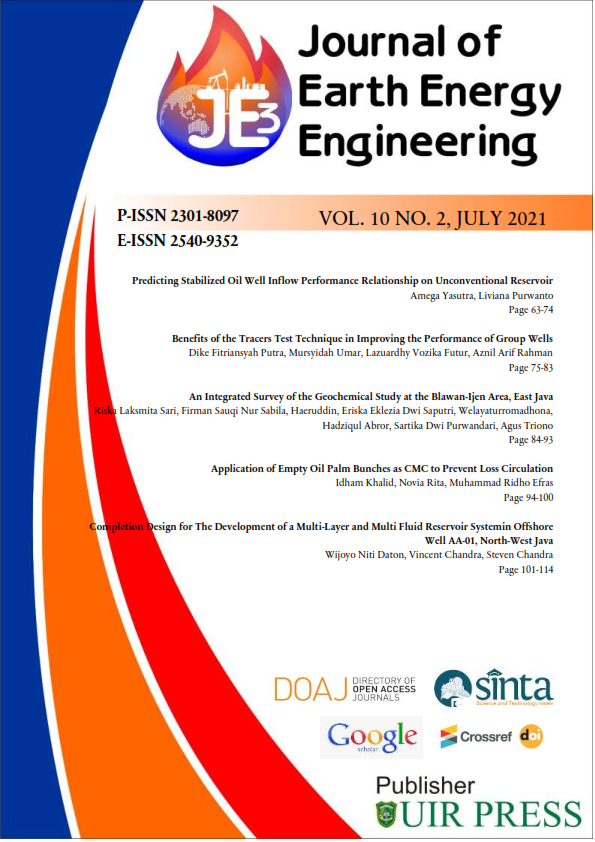Completion Design for The Development of a Multi-Layer and Multi Fluid Reservoir Systemin Offshore Well AA-01, North-West Java
Abstract
Completion systems are important components of hydrocarbon field development. As the link between the reservoir and surface facilities, completions need to be designed to maximize hydrocarbon recovery and withstand consistently changing conditions for years, within the safety requirements. However, designing completion for a well comprising a multi-layer and multi-fluid reservoir is quite challenging. The completion design must use the right materials and be able to safely produce single, as well as commingle products, and add any artificial lifts, depending on the method with the most optimum value. This paper, therefore, discusses the model development of completion design for an offshore well AA-01, one of the offshore wells with multi-layer and multi-fluid reservoir systems in Indonesia. Well AA-01 penetrates two productive layers, the upper layer AA-U1, and the lower layer AA-L2. The upper layer is a gas reservoir with initial gas in place of 1440 MMSCF, while the lower layer is an oil reservoir with initial oil in place of 6.1 MMSTB. In addition, the model design used available field data, for instance, PVT and DST, from well X. The base well completion was also used to model the completion design in software. Meanwhile, commercial software was utilized to estimate the well hydrocarbon recovery. Subsequently, several designs were tested, and the design with maximum production as well as hydrocarbon recovery was selected. The completion design selected comprises 9⅝ inch 47 ppf L-80 production casing, as well as 7⅝ inch 29.7 ppf L-80 liner, and produced commingle with oil and gas recovery of about 50.16% and 92.3%, respectively, in 5 years production
Full text article
References
Awal, M. R., & Heinze, L. R. (2009). A New Nodal-Analysis Technique to Improves Well Completion and Economic Performance of a Matured Oil Field. The SPE Production and Operations Symposium, 556–566. https://doi.org/10.2118/120632-MS DOI: https://doi.org/10.2118/120632-MS
Bonapace, J. C., & Perazzo, G. (2016, November 12). Vertical Well Completions in Multilayer Reservoirs: A Decade of Technologies Implemented in Argentina. The International Petroleum Technology Conference. https://doi.org/10.2523/IPTC-18629-MS DOI: https://doi.org/10.2523/IPTC-18629-MS
Brill, J.P., & Arirachakaran, S. J. (1992). State of the Art in Multiphase Flow. Journal of Petroleum Technology, 44(05), 538–541. https://doi.org/10.2118/23835-PA DOI: https://doi.org/10.2118/23835-PA
Brill, James P. (1987). Multiphase Flow in Wells. Journal of Petroleum Technology, 39(January), 15–21. DOI: https://doi.org/10.2118/16242-PA
Cullender, M. H., & Smith, R. V. (1956). Practical Solution of Gas-Flow Equations for Wells and Pipelines with Large Temperature Gradients. Transactions of the AIME, 207(01), 281–287. https://doi.org/10.2118/696-G DOI: https://doi.org/10.2118/696-G
Evinger, H. H., & Muskat, M. (1942). Calculation of Theoretical Productivity Factor. Transactions of the AIME, 146(01), 126–139. https://doi.org/10.2118/942126-G DOI: https://doi.org/10.2118/942126-G
Petalas, N., & Aziz, K. (2000). A Mechanistic Model for Multiphase Flow in Pipes. Journal of Canadian Petroleum Technology, 39(06), 43–55. https://doi.org/10.2118/00-06-04 DOI: https://doi.org/10.2118/00-06-04
Poettman, F. H., & Carpenter, P. G. (1952, January). The Multiphase Flow of Gas, Oil, and Water Through Vertical Flow Strings with Application to the Design of Gas-lift Installations. The Drilling and Production Practice.
Rawlins, E. L., & Schellhardt, M. A. (1935). Back Pressure Data on Natural Gas Wells and Their Application to Production Practices.
Rytlewski, G. (2008). Multiple-Layer Completions for Efficient Treatment of Multilayer Reservoirs. The IADC/SPE Drilling Conference, March, 4–6. DOI: https://doi.org/10.2118/112476-MS
Vogel, J. V. (1968). Inflow Performance Relationships for Solution-Gas Drive Wells. Journal of Petroleum Technology, 20(01), 83–92. https://doi.org/10.2118/1476-PA DOI: https://doi.org/10.2118/1476-PA
Authors
This is an open access journal which means that all content is freely available without charge to the user or his/her institution. The copyright in the text of individual articles (including research articles, opinion articles, and abstracts) is the property of their respective authors, subject to a Creative Commons CC-BY-SA licence granted to all others. JEEE allows the author(s) to hold the copyright without restrictions and allows the author to retain publishing rights without restrictions.




